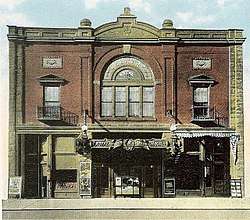Royal Theatre (Ashland, Wisconsin)
The Royal Theatre is a historic theater in Ashland, Wisconsin.[1] The theater was originally built as a vaudeville/movie theater in 1914. It was one of many theatres in Ashland to show silent films, during that era.
 The exterior of the Royal Theatre, as it originally appeared in 1914 | |
| Address | 515 Main Street West Ashland, Wisconsin United States |
|---|---|
| Type | Movie palace |
| Current use | Vacant storefronts |
| Construction | |
| Opened | 1914 |
| Years active | 1914-1957 |
| Architect | Henry Wildhagen |
The theatre was built in 1914 and owned by Abe and Louis Latts, along with Leon Schwager. The building was designed by noted architect Henry Wildhagen, who designed many buildings in northern Wisconsin, many of which are now listed on the National Register of Historic Places.
The building is of special historic interest, and is a contributing resource within the West Second Street Historic District, of downtown Ashland.[2]
The two-story brick building has a three-part symmetrical facade, which was designed in the Neoclassical Revival Style. The finely detailed facade is united by the metal entablature that features a protruding metal cornice, which has a central elliptical arch, a paneled frieze, and metal globes that stand at the top of the central pilasters in the brickwork.[2] There are brownstone quoins at the sides, as well as brownstone window sills. Originally, there was a cast iron canopy over the central entrance,[2] with ornate light fixtures on either side, and the name Royal Theatre embossed on the front.
One of the central features of the interior was a massive bronze sculpture of a lion, which was prominently displayed in the lobby. The sculpture was life-sized, and rested on a massive marble pedestal. Lions were featured throughout the overall design and motif of the building, and the sculpture in the lobby was an excellent example of the cultural depictions of lions in classical architecture.
Eventually, a new marquee was added, with neon letters, in the Art Deco style, which didn't necessarily fit with the building's overall classical architecture. This marquee was later removed, after the theatre closed in 1957.[1][3]
In the 1960s the building was converted into space for retail stores.[1][3] The building survived a fire in the 1960s, and luckily wasn't demolished.
References
- "Cinematreasures.org". Retrieved 19 March 2017.
- Steve Sennott (February 1983). "National Register of Historic Places Inventory/Nomination: West Second Street Historic District". National Park Service. Retrieved March 19, 2017. With 51 photos from 1983
- "Ashland Historical Museum". Retrieved 19 March 2017.